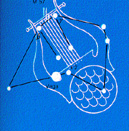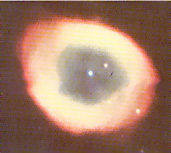|

Easily recognizeable for the presence of the most luminous star of the Summer sky, Vega, the little but particularly interesting constellation of Liras remind of the instrument of Orpheus.
Seen with whatsoever optical tool, Vega is an unforgetteable vision.
Vega has got also a famous exordious: on the eve of 16th of July 1850 the astronomous W.C. Bond gained from Harvard Observatory the first stellar pic, exactly the one of Vega.
Near to Vega, more or less one degree and a half toward East there's one of the most interesting multiple stars: the Epsilon 1 and the Epsilon 2 of Liras. They apparently seem just two stars, but actually they are four.

The Ring Nebula of Liras , code name M52, with its beautiful series of colours.
Not easily seable without a pretty decent tool, it'll steal your heart when you'll look at it thru a good telescope. |
 |
|
|  |
|
The Liras was for ancient Greeks the most noble of instruments.
Played and consecreted to Apollo, God of Sun and Music, it was played in a wonderful way also by an human, handsome young man named Orpheus.
His music with liras was so melodic and touching all animals and creatures were enraptured by it as soon as he was playing it around.
One day Orpheus met Euridice, a stunningly beautiful Nimphas of Woods. They married but the poor Euridice, suddenly biten by a snake, died in Orpheus arms as soon as she pronounced the I Do formule.
Sent directly to Ade's afterlife Reign, she left Orpheus destroyed.
The young lover, unaccepting her death went to the Ade's Reign asking for the King of Afterlife to let Euridice coming above ground with him newly alive, and for being able to see Ade he played the lira making Cerberus, the famelic three headed dog watching the Reign entrance sleeping softly due to the melody.
|
 |
|
|
|

